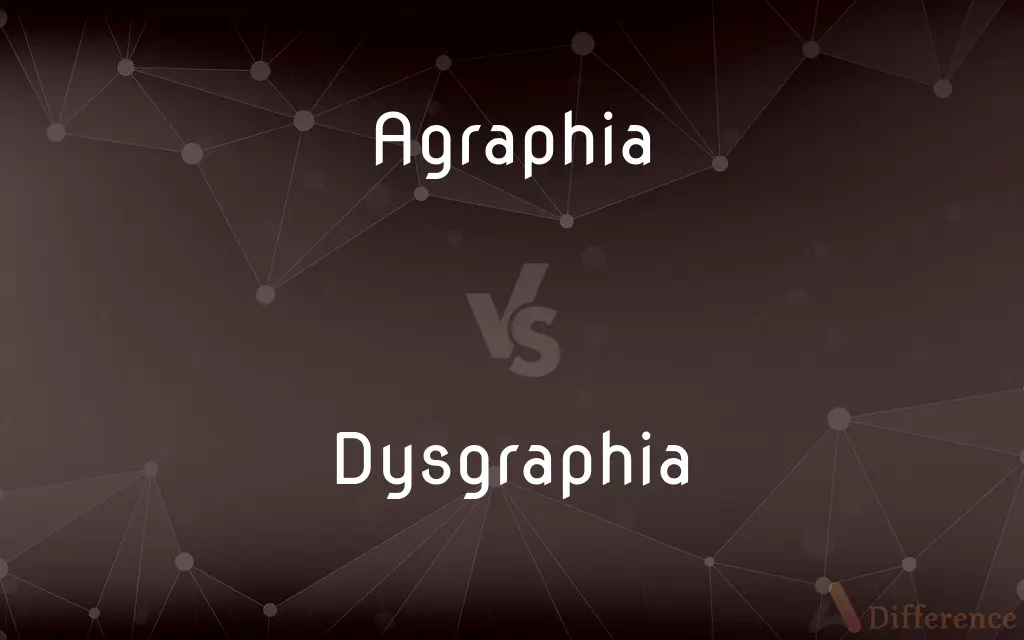Agraphia vs. Dysgraphia — What's the Difference?
Edited by Tayyaba Rehman — By Fiza Rafique — Updated on April 2, 2024
Agraphia is the loss of the ability to write due to brain injury, while dysgraphia is a neurological disorder that impairs handwriting ability and fine motor skills.

Difference Between Agraphia and Dysgraphia
Table of Contents
ADVERTISEMENT
Key Differences
Agraphia is a condition resulting from brain damage, often due to stroke, trauma, or other neurological conditions, leading to a partial or complete loss of the ability to write. It is typically acquired after an individual has already learned to write. In contrast, dysgraphia is a specific learning disability that affects writing, which can manifest as poor handwriting, trouble with spelling, and difficulty putting thoughts on paper. Dysgraphia is often diagnosed in children during their learning years and can persist into adulthood.
Agraphia involves the disruption of previously acquired writing skills, reflecting damage to specific brain regions responsible for writing. Dysgraphia, however, stems from neurological differences that affect the physical act of writing and the cognitive process of composing text, without a history of acquired writing skills being lost.
Treatment and management of agraphia focus on rehabilitation aimed at recovering writing abilities and may involve occupational therapy, speech therapy, and the use of alternative communication methods. Dysgraphia interventions often include educational support, such as accommodations in the classroom, occupational therapy to improve fine motor skills, and the use of assistive technology.
The impact of agraphia is directly tied to the loss of a previously held ability, which can be particularly frustrating and challenging for affected individuals. Dysgraphia's impact, while also significant, relates more to the development of writing skills and can affect academic performance and self-esteem, particularly in students.
Understanding the distinction between agraphia and dysgraphia is crucial for providing the appropriate support and intervention. While both conditions affect writing, they differ in their origins, implications, and management strategies.
ADVERTISEMENT
Comparison Chart
Cause
Brain damage (e.g., stroke, trauma)
Neurological disorder
Effect
Loss of previously acquired writing ability
Impaired handwriting ability and fine motor skills
Diagnosis
After brain injury
Often diagnosed in children
Treatment
Rehabilitation, therapy, alternative communication
Educational support, occupational therapy, assistive technology
Impact
Frustration from loss of ability
Challenges in academic performance and self-esteem
Compare with Definitions
Agraphia
A specific form of agraphia where the ability to read is preserved, but writing is impaired.
Despite his pure agraphia, he could still read newspapers without issue.
Dysgraphia
A neurological disorder characterized by difficulties with handwriting, spelling, and organizing ideas on paper.
Dysgraphia makes it hard for him to complete written exams within the time limit.
Agraphia
A loss or impairment of the ability to write caused by brain injury.
After the stroke, she experienced agraphia, making it difficult to write her name.
Dysgraphia
Difficulty in spelling and writing phonetically.
Phonological dysgraphia causes him to struggle with sounding out words for spelling.
Agraphia
Difficulty in the motor planning and execution needed for writing.
Apraxic agraphia made it challenging for him to form letters correctly.
Dysgraphia
Impaired fine motor skills leading to poor handwriting.
Her motor dysgraphia was evident in the uneven spacing and size of her letters.
Agraphia
Agraphia accompanied by an inability to read.
His alexic agraphia meant he struggled with both reading and writing post-injury.
Dysgraphia
Difficulty with the spatial arrangement of text on the page.
Spatial dysgraphia leads to his written work appearing disorganized and crammed.
Agraphia
Severe writing impairment affecting all aspects of writing ability.
Global agraphia left her unable to communicate effectively through writing.
Dysgraphia
Trouble with the visual aspect of letters and words.
Orthographic dysgraphia affects her ability to remember and reproduce the correct spelling of words.
Agraphia
Agraphia is an acquired neurological disorder causing a loss in the ability to communicate through writing, either due to some form of motor dysfunction or an inability to spell. The loss of writing ability may present with other language or neurological disorders; disorders appearing commonly with agraphia are alexia, aphasia, dysarthria, agnosia, acalculia and apraxia.
Dysgraphia
Dysgraphia is a deficiency in the ability to write, primarily handwriting, but also coherence. Dysgraphia is a specific learning disability (SLD) as well as a transcription disability, meaning that it is a writing disorder associated with impaired handwriting, orthographic coding and finger sequencing (the movement of muscles required to write).
Agraphia
A disorder marked by loss of the ability to write.
Dysgraphia
A neurological disorder marked by impairment of the ability to write, especially to write by hand and to spell. It can occur as the result of brain damage or in association with learning disabilities.
Agraphia
(pathology) A loss of the ability to write (usually resulting from a brain injury).
Dysgraphia
A language disorder that affects a person's ability to write.
Agraphia
The inability to write.
Dysgraphia
Impaired ability to learn to write
Agraphia
The absence or loss of the power of expressing ideas by written signs. It is one form of aphasia.
Agraphia
A loss of the ability to write or to express thoughts in writing because of a brain lesion
Common Curiosities
How can technology help individuals with dysgraphia?
Technology, such as speech-to-text software and word processors with spell check, can help individuals with dysgraphia by reducing the need for handwriting and assisting with spelling.
What kind of professionals diagnose and treat dysgraphia?
Dysgraphia is often diagnosed by psychologists through assessments and treated with the help of occupational therapists and special education teachers.
Can dysgraphia be cured?
There is no cure for dysgraphia, but strategies and accommodations can significantly improve writing skills and academic performance.
Are agraphia and dysgraphia considered disabilities?
Agraphia is a result of brain damage, so it is considered a neurological impairment. Dysgraphia is recognized as a specific learning disability.
How do these conditions affect daily life?
Agraphia and dysgraphia can impact daily life by making written communication challenging, affecting personal, academic, and professional activities.
Is agraphia always permanent?
Agraphia's permanence depends on the extent of brain damage and the success of rehabilitation. In some cases, individuals can recover some writing abilities.
What are the emotional impacts of these conditions?
Both conditions can lead to frustration, lowered self-esteem, and anxiety, especially in communicative and academic settings.
Can adults develop dysgraphia?
Dysgraphia is typically identified in children, but adults can exhibit symptoms, especially if it was never diagnosed in childhood.
Can individuals with these conditions live normal lives?
Yes, with appropriate strategies, therapies, and accommodations, individuals with agraphia and dysgraphia can lead successful and fulfilling lives.
Are there any famous people known to have agraphia or dysgraphia?
There are several notable individuals believed to have faced challenges with writing, including historical figures and celebrities who have been open about their struggles with learning disabilities similar to dysgraphia.
Share Your Discovery

Previous Comparison
Canyon vs. Ravine
Next Comparison
Salmonberry vs. RaspberryAuthor Spotlight
Written by
Fiza RafiqueFiza Rafique is a skilled content writer at AskDifference.com, where she meticulously refines and enhances written pieces. Drawing from her vast editorial expertise, Fiza ensures clarity, accuracy, and precision in every article. Passionate about language, she continually seeks to elevate the quality of content for readers worldwide.
Edited by
Tayyaba RehmanTayyaba Rehman is a distinguished writer, currently serving as a primary contributor to askdifference.com. As a researcher in semantics and etymology, Tayyaba's passion for the complexity of languages and their distinctions has found a perfect home on the platform. Tayyaba delves into the intricacies of language, distinguishing between commonly confused words and phrases, thereby providing clarity for readers worldwide.
















































